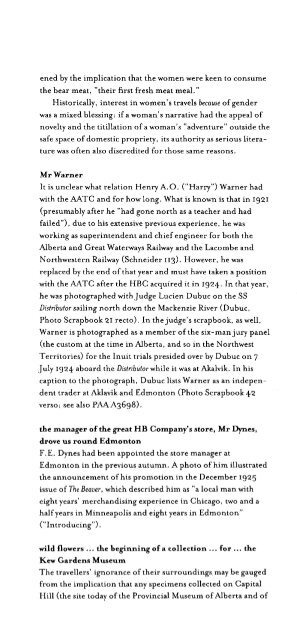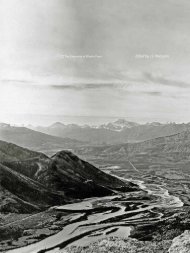C Ihe Ladies c cu. V'VVAN - History and Classics, Department of
C Ihe Ladies c cu. V'VVAN - History and Classics, Department of
C Ihe Ladies c cu. V'VVAN - History and Classics, Department of
- No tags were found...
Create successful ePaper yourself
Turn your PDF publications into a flip-book with our unique Google optimized e-Paper software.
Notrs to Pages 17-22 243ened by the implication that the women were keen to consumethe bear meat, "their first fresh meat meal."Historically, interest in women's travels because <strong>of</strong> genderwas a mixed blessing: if a woman's narrative had the appeal <strong>of</strong>novelty <strong>and</strong> the titillation <strong>of</strong> a woman's "adventure" outside thesafe space <strong>of</strong> domestic propriety, its authority as serious literaturewas <strong>of</strong>ten also discredited for those same reasons.MrWarnerIt is unclear what relation Henry A. O. ("Harry") Warner hadwith the AATC <strong>and</strong> for how long. What is known is that in 1921(presumably after he "had gone north as a teacher <strong>and</strong> hadfailed"), due to his extensive previous experience, he wasworking as superintendent <strong>and</strong> chief engineer for both theAlberta <strong>and</strong> Great Waterways Railway <strong>and</strong> the Lacombe <strong>and</strong>Northwestern Railway (Schneider II3). However, he wasreplaced by the end <strong>of</strong> that year <strong>and</strong> must have taken a positionwith the AATC after the HBC acquired it in 1924. In that year,he was photographed with Judge Lucien Dubuc on the SSDistributor sailing north down the Mackenzie River (Dubuc,Photo Scrapbook 21 recto). In the judge's scrapbook, as well,Warner is photographed as a member <strong>of</strong> the six-manjury panel(the <strong>cu</strong>stom at the time in Alberta, <strong>and</strong> so in the NorthwestTerritories) for the Inuit trials presided over by Dubuc on 7July 1924 aboard the Distributor while it was at Akalvik. In hiscaption to the photograph, Dubuc lists Warner as an independenttrader at Aklavik <strong>and</strong> Edmonton (Photo Scrapbook 42verso: see also PAAA3698).the manager <strong>of</strong> the great HB Company's store, Mr Dynes,drove us round EdmontonF.E. Dynes had been appointed the store manager atEdmonton in the previous autumn. A photo <strong>of</strong> him illustratedthe announcement <strong>of</strong> his promotion in the December 1925issue <strong>of</strong> The Beaver, which described him as "a local man witheight years' merch<strong>and</strong>ising experience in Chicago, two <strong>and</strong> ahalf years in Minneapolis <strong>and</strong> eight years in Edmonton"("Introducing") .wild flowers ... the beginning <strong>of</strong> a collection ... for ... theKew Gardens MuseumThe travellers' ignorance <strong>of</strong> their surroundings" may be gaugedfrom the implication that any specimens collected on CapitalHill (the site today <strong>of</strong> the Provincial Museum <strong>of</strong> Alberta <strong>and</strong> <strong>of</strong>the residence <strong>of</strong> the lieutenant -governor <strong>of</strong> the Province <strong>of</strong>Alberta) would be new to the Kew Herbarium. This need, if ithad not already, would have been met by the F a<strong>cu</strong>Ity <strong>of</strong> Scienceat the University <strong>of</strong> Alberta, established in 1908 across the riverfrom the ladies' collecting grounds.DunveganDunvegan Yards remains on the east side <strong>of</strong> St Albert Trail,north <strong>of</strong> the Yellowhead Trail, now well within Edmonton'scity limits. It was the departure point for trains travelling the480-km (300-mi) route to Waterways on the Alberta <strong>and</strong>Great Waterways Railway line (Kitto, North West 56). This train,which had earned the nickname <strong>of</strong> "Muskeg Limited" by 1920,when Philip Godsell rode it, was one <strong>of</strong> four Government <strong>of</strong>Alberta lines. Construction <strong>of</strong> it began in December 1913 <strong>and</strong>was completed as far as Lac la Biche in February 1915(Schneider 75,79: Hatcher, NorthernAlberta I).Godsell's description <strong>of</strong> it in 1920, when contrasted withVyvyan's, suggests that the train had both improved greatly butalso lost some <strong>of</strong> its colourful character by 1926:... a conglomeration <strong>of</strong> dirty red box-cars, flat-cars, <strong>and</strong>one very rickety old-fashioned coach with a caboose tackedon to the rear ....The lucky ones got hard plush-covered berths in thecoach but the majority were forced to make the best <strong>of</strong> theopen flat-cars. As the engine gave her last wheezy whistle thenondescript train, with much bumping <strong>and</strong> a good deal <strong>of</strong>noise <strong>and</strong> ostentation, commenced her swaying journeythrough prairie l<strong>and</strong> <strong>and</strong> muskeg.Twice a day there would be a brief stop for meals, thenthe passengers would all pile out onto the track with fryingpans <strong>and</strong> tea kettles in their h<strong>and</strong>s, build hurriedcampfires, sling on the kettles, warm up a tin <strong>of</strong> pork <strong>and</strong>beans <strong>and</strong> snatch a hasty meal.After the first fire every one knew everybody else <strong>and</strong> theartificial barriers which civilization imposes were very soonlet down ....A truly remarkable railroad was the A. & G. W., as therotting box-cars, which had fallen from the crazy track intothe ditch, so amply testified. Straight ahead it went, up hill,down dale, through the woods <strong>and</strong> into the deepest muskegswhere, for hours at a time, the rails would be invisiblebeneath the watery slime. Once or twice, after frenzied
















